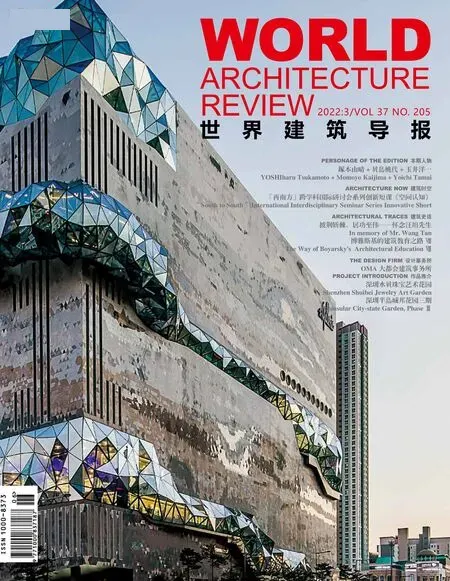人物访谈
刘珩:感谢塚本由晴先生欣然接受《世界建筑导报》的采访。您能将研究、学术和实践结合,这对于建筑师来说并不常见。许多年来,您已经有许多关于共有性(commonality)、地质学以及东京城市研究的出版物。您对”非对称化”的表达已被我们所熟知,这种特殊的风格将您的研究转化为图示。谈到您在日本的建筑设计实践,一些建筑师非常注重在构造方面的钻研,但您将以上种种进行融合,形成社会性的、富有逻辑的且富有成效的表达。这与日本的其他建筑非常不同。请问您如何考量工具、研究和实践的关系,您的研究与实践如何相互影响?
塚本由晴:我在东京工业大学师承坂本一成学习建筑,在那里他既是设计教授,也是建筑师和学者,同时进行学术写作、研究与设计实践,这个方向确立于谷口吉郎创建之初。我意识到两者兼顾是件很有趣的事。我想要建立一个研究的游乐场,寻找建筑设计游乐场的途径。建筑实践将会拓展游乐场的领域,因此研究和实践并不矛盾。
一个重要原因是我试图联系建筑背景来理解设计。犬吠建筑事务所认为建筑设计并非将我们的想象力强加给设计对象。与20 世纪许多建筑师相比,我们不太坚持这种层面上的独创性。对我们而言,建筑设计是协调、平衡和建立关联,让事情行之有效。从这个意义上说,建筑设计可以通过结构化事物间的关系而得到,这可以是主观的关系,指向建筑、也可以指向周围用户的体验。最重要的是每个项目的范围,它们是某些类型建筑的关键切入点。通过观察和观察过往案例,我们能找到其背后的结构和网络,理解材料和关系如何应用于某些条件与项目中,来推动设计,进而优化要素关系,这种干预就是建筑设计的驱动力。
刘珩:这是一个有趣的观点。一般而言,从创意到形式是一种自上而下、比较强势的设计方法,但您提出自下而上地、通过协作、问题和关系来进行设计,处理背后逻辑结构和框架。这种兴趣会激发您进行进一步的研究。是这样吗?
塚本由晴:是的。写作也如同图示制作一样需要运用结构,这个结构可以很“建筑”。这就是为什么我喜欢写作,也喜欢制图的原因。有时我会制作表格来解释和比较不同的对象,要保持观察方式的一致性。我在学校教授的深度设计需依靠制作表格来进行对比和强化,精美设计的图表确实能够帮助你推进设计思考。有时,学生没有能力创造合适的表格和图表来推进项目。制作图表看似与建筑设计相去甚远,但对我而言,它们极为重要且非常相似。
刘珩:这是一个非常有趣的方法论,通过写作、草图和图表将基础研究资料进行组织与再现,并在此基础上发展为设计。你如何把这种方法教授给学生,并确保他们遵守这种规则?
塚本由晴:是的,他们做同样的事情,但确实一开始很难教出最合适的方式。我们的确有主题与目标,但不知如何表述和比较,能够配合适当的图示表达。学生会先研究往案例和研究,而我要寻找与主题本身碰撞过程中、思想和认知改变的那一时刻。每次我也尝试根据主题开发新的图示,这个过程需要时间但很有趣。一旦找到图形表达的方式,所有主题就变得很容易,让你去思考更多案例,这就是设计过程。实际上,建筑学术写作和研究非常基于这种设计方法论和图形表达。
刘珩:您的黑白图纸一经问世便在建筑领域影响广泛。您所说的“主题”和”图形表达“,到底谁先谁后?或许您先尝试多种图形表达,然后找出最喜欢的图示?
塚本由晴:是的,我会自己尝试并向学生展示前期草图。在一个农业区项目中,我们同一群在那里工作了23 年的农民一起复兴当地的住户、水稻梯田和村庄,他们已经在地开展艺术交流项目长达15 年。我们则是从 2019 年开始工作,三年以来建造房屋,并将仓库改造成画廊空间,设计社区厨房,开设农场,自己种田等等。现在我们正在转向下一个阶段,在这片土地上为城市来的人们建造小房子,这样他们就能留下来并参与到务农活动中来。我们现在正在设计这些小房子的总体规划。为了给它们找到合适位置、完成设计和建造,我们需要新的图形表达。我建议用等高线来代表设计,但在微观尺度上图绘并不精确,学生以1 米为基本单位绘制的等高线无法捕捉到地貌特征,我又建议他们将等高线密度改为每25 厘米一条,便能很好地呈现出丰富的景观细节。如此,找到正确的方式来构建图纸,至关重要。
刘珩:我们了解到您推崇的表现形式很像《清明上河图》。那是一幅展现滨河集市的长卷。这和您的绘图方式有点类似,没有等级,同时呈现一切,将日常生活和公共空间并置在一起。这背后是否暗含着你的设计哲学?此外,我认为“精确”这一关键词对理解您的主题和研究、以及图示呈现方式非常重要。但要做到精确并不容易。
塚本由晴:我教导学生去精确观察,这是对事物产生的一种情感形式。精确观察可将这种情感转变成主题。我尊重那些我们无法真正接触或改变的事物,但是我们能够改变其关系和框架。当事物被放置在不同的关系和框架中时,我们便能拓展其不同表征。我对引导它们运作的方式非常感兴趣。精确的书写和图绘展现出我们对事物的兴趣与尊重。我们不能改变每一个事物,但我们仍然可以与之互动。从这个意义上说,“游乐场”是非常准确有效的表达,我们可以在其中与事物“玩耍”。
刘珩:我第一次听到“游乐场”这个词。当您提到研究和建筑实践之间的关系时,您将研究作为一种手段来强化或启发“游乐场”的形成。为什么使用“游乐场”来定义实践?这也是“共有性”的一部分?
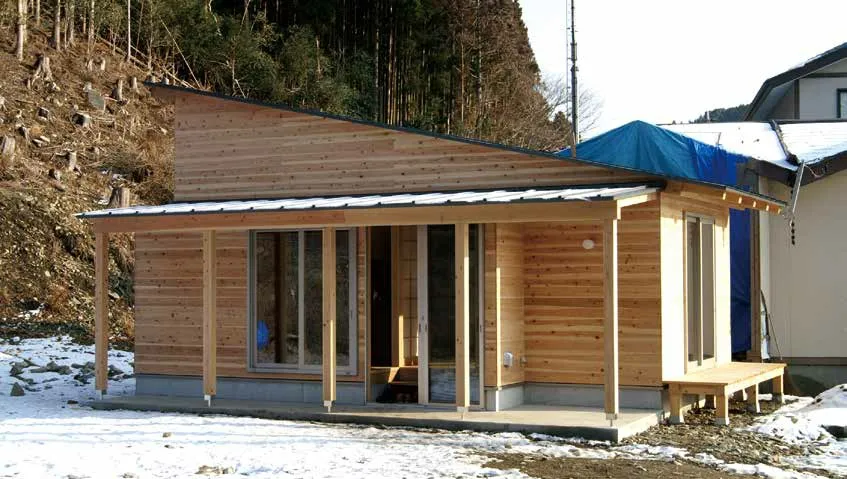
Core House,Ishinomaki Miyagi
塚本由晴:研究和设计都是在处理和创造“游乐场”。试图用类似《东京制造》所采用的简单线条表现引导着许多年轻的建筑师和学生去展示各自生活的环境和城市,这就意味着他们已加入到这个《东京制造》的“游乐场”中。《东京制造》的这种建筑图示方式使得人们能与迷你景观和农业建筑等并不夺目的设计类型互动,以特殊的方式来欣赏它们。共有性是解释“游乐场”的另一种方式,大家都能拥有并参与其中。特定的环境引发人们将城市空间调试和转换为非常活跃的公共空间。我对共有性感兴趣,是因为它已经暗藏于我们每个人的内心,并融入到开放空间中,成为大家所共享的一种空间习性或文化。《共有性》(Commonality)作为一种建筑领域,重视人的行为对公共空间的运作的影响,因为这种行为就是建筑能够影响的一种“游乐场”。“共有性”就是在城市中寻找人们能参与的游乐场,通过观察人们的行为、文化背景和生活习惯,我们能利用资源而使其成为可能。《共有性》就是一本关于“游乐场”的书。
现代建筑类型的背后是现代教育理念,它体现在学校、文化博物馆和医院中;行为也遵循这个概念。当人们渐渐习以为常,便学会如何享受和利用这些制度化的现代设施,进而成为现代人。但我所关心的共有性与制度化设施不同,概念不会超越现象而先行。行为总是优先,而后集体行为创造出一种调试城市空间的方式,从而最终变成文化和习惯、乃至变成可被享受的场所,这就是游乐场。
刘珩:这是一个相当系统的框架。你的研究和实践都以行为为中心,个人行为变成集体行为,然后变成制度,而制度最终形成文化。这与您的个案实践如何关联?
塚本由晴:机构是个自上而下的概念,规范人们在设施中的行为。我对用行为来颠倒这种方式很感兴趣。当个体行为成为集体行为,就能创造一种有包裹感的场所。人们可以做同样的事情来一起享有它。设计也可以自下而上。你不能改变物质元素或禁止某种方式,但可以适当引导它们。比如说引导水的行为,我们能通过设计使之成为令人鼓舞和愉悦的水。万物皆有行为,当我们充分了解物质的运作方式,就能成功地引导它们。
行为学是我采用的建筑手段的重要基础和设计理念,也是研究日常生活、环境和社会的方法,设计研究就是去了解行为的发生。有时我们也观察到因为某些思维定势的社交障碍而阻碍了行为的发生。所以建筑设计可以是一种虚构作品,激发我提出一系列虚构的设定。我经常使用“行为解锁”这个词,用建筑的无形来引导行为,打造更好的可达性来突破障碍。例如采集城市落叶来在城市街道上生火做饭,包含两种毫无瓜葛但始终在城市中共存的方式。如果我们能很好地结合这两种事件,这便是行为解锁。再比如犬吠事务所房子就属于介于家庭住宅和办公室之间的混合类型,20 世纪社会规范告诉人们要将家庭生活区和工作区分开,但我认为生活和工作混合是可能的,很容易便可打破社会规范来解锁行为。
刘珩:说点不一样的。你们在威尼斯双年展中展示过参与地震灾后建设,使得你去了解世代相传的、狭小的私有土地的关系与使用方式,这是非常跨学科的、针对空间基础结构的考古、规划和经济研究。该如何理解这种研究?
刘珩:很有趣。你相信进化或突变?
塚本由晴:这很重要且有趣,因为受环境情况和条件的影响。设计实践最重要的挑战是创造新兴人群,我认为设计可以做到这一点。
刘珩:那么让我们谈谈未来。因此,当我们谈论您认识的新型人以及突变时,因为在过去的几年中,Covid-19成为我们日常生活的新常态。我们准备好了吗?现在社会的生活方式将如何重塑。你将不得不重新处理自己以适应新的条件,城市中的很多空间,也成为了一个非常激进的时刻,只是给我们重建日常空间留下了很多不确定性。
塚本由晴:我认为这很重要。如何重建我们的生活是大多数讨论的主题,城市生活完全依赖于工业服务,我称之为“冷酷的人力资源”。新冠病毒等自然灾害向我们展示了脆弱的社会系统。我提出应将生活方式从人力资源转变为人的资源,人可以得到周边的资源,获取食物和能量以构建生活。城市中的资源非常有限和受控,但你可以走出来而打造一种复合生活模式。周末我都把时间花在农田里,从山野中获得食物和能量,自己做饭,感觉变得越发丰富了。建筑、城市和社会都是为人力资源而设计,我认为可以重新设计它们;对那些依赖于工业社会网络的人们来说,没有人的资源则是一种生命的缺失。
刘珩:那么你下一步的研究或实践是什么?
塚本由晴:我正在考虑组建一个新的设计学院,就在山区农村。过去两年中,我和我的学生在这里非常努力地工作,建造老房子、社区厨房、客舍和配有火炉和储藏的画廊,开辟草地和竹林的田地并种植水稻,我们还维护森林以便建筑木材之需。在非常有限的偏远地区,物质循环很重要。我们向自然学习技能,以及在与泥巴、竹子、种子、树木和水等自然元素打交道之时学到各种务农的技巧。我要为设计学院打造一个新的课程体系来教授设计新思维,这将是“游乐场”的一种新方式。来自四所大学的学生将在农场和山林间学习理解事物的关联网络,他们并不一定是建筑系学生,小凉亭和住屋使得城市居民能够留下来,建造材料均产自当地,这有助于理解环境的影响。这种工作方式让我非常振奋。
Doreen Liu (DL):Mr.Yoshiharu Tsukamoto,thanks for accepting the interview by World Architecture Review.You are excellent in combining research,academic and practice,which is rare for architects.You already have many publications about commonality,geology,as well as urban studies in Tokyo.We are very familiar with your theory on the asymmetric style.It is a very particular manner to translate your research into graphic presentation.In the architectural design’s point of view,some works of architects are very tectonic.You,on the other hand,are more integrated,not only of tectonics but also of social,logical and productive presentation.This is very different from other Japanese architects.So the first question is about the tool,research and practice.How do you consider them in the dynamics of your research and practice?
那几天,她拼命打他的电话,她的话在心里憋着,电话却一直打不通。终于打通一次,她歇斯底里的叫喊:“饶建,你他妈的不是人,你为什么躲我,要不把你的房子烧了,要不,我栽进湖里!”
Yoshiharu Tsukamoto (YT):I studied under the supervision of Kazunari Sakamoto at Tokyo Institute of Technology.He taught there as Design Professor,practicing architect and scholar,a tradition inherited from Yoshiro Taniguchi who founded the school.I’m impressed naturally by this mode and feel like working on both.One of the possible answers for me is to make a playground for research and architectural design.The latter will expend the realm of the playground,which combines research and design practice.
One important reason is that I try to understand architectural design with its background.Atelier Bow-Wow thinks architectural design not as something to impose our own imagination.We do not insist on such originality in comparing with contemporary architects.For us,architectural design is to coordinate,balance and relate with different things and finally to make them work well together.In that sense,architectural design can be structuralized by the relationship between several things.They can be subjective.We can study the relationship that reaches architecture and the experience of the users around.What is the most important is the scope of each project,which becomes the key issue in certain type of buildings.Discussing all these through watching and observing the precedent cases,you find a kind of structure and network behind it.We can understand how these materials and relationships go apply to these conditions,to work on projects,then to modify elements and relationship -a kind of intervention as the driving force of architecture.
DL:It is an imposing key word because architecture is more like a top-down process to bring ideas into forms.But you suggest an alternative design through coordination,problem-oriented and relationship.You deal with its logical structure and framework.That is kind of interest that inspires your further research.Right?
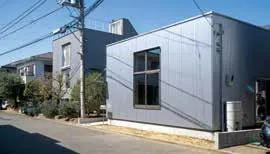
Haha 屋(日本,神奈川)Haha House (Chigasaki Kanagawa,Japan)
YT:Yes.It is equally true for writing which is like making graphics with structure.It can be very architectural.It’s why I like writing and working on graphic.Sometimes,I do a kind of table to explain and compare different things in a consistent manner of observation.I teach in the school very detailed design in a way of making tables to compare and emphasize them.Well-designed tables and graphics really help you to build thoughts.Sometimes,our students do not have skills to set up the proper tables and graphic representation for design.It looks like far from designing architecture,but a very important and identical tool for me.
DL:That’s a very interesting methodology.It means you do writing,sketches and diagrams.After organizing these on-field materials,you present the finding and then develop it into a design.How do you teach student about this and do they work as same as you do?
YT:Yeah,they do the same thing.It’s very difficult to teach in a most appropriate manner in the beginning.We have subject and target,but we don’t know how to represent and compare them with the help of proper graphic representation.Students are asked to examine previous cases and studies,and test several options.What I am looking for is the moment during which we change our minds and perceptions through encountering with the subject itself.And then the graphic.Every time I try to invent new graphic representation according to the subject.This process takes time but very interesting.Once you find the manner of graphic representation,all the subjects become quite easy to continue and to explore your thoughts to more cases.It is really a design process.Actually,academic writing and study on architectural design is very much based on that kind of design methodology and graphic representation.
DL:When your black-and-white drawings and renderings came out for the first time,it was shocking to the field of architecture worldwide.As you said about subject and presentation,which comes first?Perhaps you try different ways of presentation first,then find out the graphic you like most?
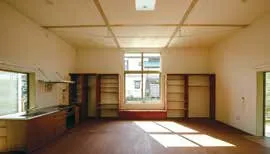
Haha 屋(日本,神奈川)Haha House (Chigasaki Kanagawa,Japan)
YT:Yeah,I try to show very rough sketches to students.For example,now I am working in farming area.We are revitalizing the popularity,rice terraces and villages together with interesting farmers living there for 23 years who invent different art and exchange program last 15 years.We go there 3 years ago from 2019,making house and transform the storage buildings into gallery space.We design community kitchen,open the farms and now grow rice by ourselves.Now we are shifting to another stage to building citizens’ tiny house in this fields so that people from cities can stay and also participate into farming.We are now designing the master plan of these tiny houses.In order to draw all these ideas to find the proper spot to build tiny houses,we need new graphics.I suggest translating the plan into contoured lines.But drawing doesn’t actually tell what happens in the micro scale.Now students utilized contour lines of every one meter,it’s already quite detailed but this resolution cannot really catch the topography of the rice terrace.So I propose them to densify the contour lines into every 25 centimeters.Now it’s working.By watching these contoured lines,different parts of landscape start to appear.Finding the proper manner and elements to construct the drawings is very important.
DL:We find out your presentation style and manner similar with a famous Chinese painting,Riverside Scene at Qingming Festival.It’s a long-scroll,riverside view of markets.Your drawing style is similar without hierarchy;and everything,including daily life and public space,co-exists simultaneously.So is there a kind of design philosophy behind it? Also,being“precise” is very important to understand your subject and research,as well as the graphical way you present.However it is not easy.
YT:I teach students to watch precisely and it’s one of the forms of affection to things.Watching precisely can turn affection into subject.I respect those things that we cannot really touch and change.Yet their relationship and framework are possible to change.By putting things with different relationships and frameworks,we could explore all their performances.I am interested in working with them and guide their performance.Writing and drawing precisely reflects our interest to respect things.We cannot change everything,but still we can do something with them.In that sense,the playground is again a quite useful and accurate expression.We can play with them.
DL:This is my first time to hear about the word“playground”.When saying the relationship between research and architectural practice,you set research as a means to enforce or inspire the playground.Why do you use “playground” to define practice? Is it a kind of definition for commonality?
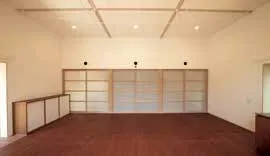
Haha 屋(日本,神奈川)Haha House (Chigasaki Kanagawa,Japan)
YT:Both research and design deal with playground.The book of Made in Tokyo uses simple lines of drawing that inspire young architects and students to show their own living environment and cities.It means that they have joined our playground establish via Made in Tokyo.With it you can play with miniscape and agri-architecture,either of not necessarily beautiful architecture.Then you can appreciate these buildings in a special manner.Commonality is another way to explain the playground.Commonality is a chair that anyone can own and join to sit with.Certain circumstance triggers the human behavior to appropriate and transform the urban area into a very vibrate public space.The reason why I am interested in commonality is because that it has already been embedded into each individual,and also stoned into the open space and shared among people as a kind of habit or culture of space.Commonality as an architectural realm tries to see the operation of public space in terms of human behavior,a very important playground for architecture to intervene.Commonality seeks in the city the playground which is for people to join in and utilize.Through observing the behavior,cultural background and habits of people,we utilize resource to achieve it.Commonality is a book of playground.
Behind the modern building types,there is a modern concept of education,which multiplies in schools,cultural museum and hospitals,etc.Then behavior follows this concept.When people gradually get used to it,they learn how to enjoy and utilize these facilities as buildings of institution,and then become modern people.They are buildings of institution.But I relate most to commonality with those that are different from institutional facilities,No concept precedes phenomena.Behavior comes first,and the collective behavior creates a kind of spatial manner to appropriate the city.Then it becomes culture,habit and a place that people enjoy– the playground.
DL:It’s quite a systematic framework.Your behaviorcentered research and practice makes individual behaviors into collective ones,and it becomes institutionalized and eventually culture.How can this lead to your case-by-case practice?
YT:Institution is a top-down concept to let people learn to behave in facilities.I am interested in an upsidedown process that starts from behavior.Once behavior becomes collective,it delivers a kind of place with enclosure.Everyone can enjoy it at the same time by doing the same things.Design can be also bottom-up.You cannot change the nature of element or prohibit certain manner,but we can guide them to perform in certain direction.If talking about the behavior of water,we design and make it encouraging and pleasing.All things behave.We understand the nature of elements about how they behave,then we can guide and make them work together.
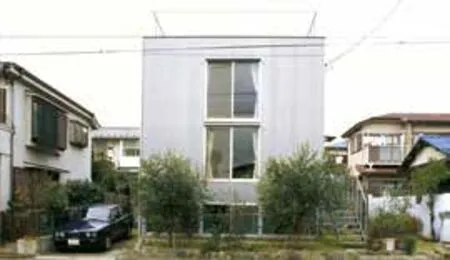
ANI 屋(日本,神奈川)ANI House (Chigasaki Kanagawa,Japan)
Behaviorology is a very important basis for my architectural suits and design philosophy.It is also the method of studying everyday life,environment and society.Design research is to understand what happens to behavior.Sometimes we also find behavior being blocked due to mind-set social barriers.So architecture design can be a kind of fiction that interests me to introduce fictional scenarios.I often use the word “unlocking behavior” to use invisible architecture that guides our behavior to overcome barriers with better accessibility.For example,we collect mass debris from the maintenance of trees and cook with real fire on the city street.The two behaviors never meet each other,yet existing all the time.It is unlocking behavior if we make them work together.For example,my Bow-Wow house is of a very hybrid form between family house and architectural office.People follow 20th-century social canon and believe that house is simply dedicated for family,and office for work,which leads them to separate from each other.But living and work can possibly be together.I think it easy to break the social canon and to unlock behavior.
DL:Let's talk about something different.In the Venice biennial,I know you are very active in participating after-earthquake reconstruction.It leads you to understand the relationship and use of land through generations.You try to reflect that kind of understanding by examining very narrow,individually owned piece of land.That is very interdisciplinary from archaeology,planning and economy in terms of spatial infrastructure.How does this interdisciplinary research define itself?
YT:It is a study of ethnography,urban ecology and topology for the construction of daily life.For example,in the study of metabolism,a sequence of four generations defines the direction of design based on a genealogical transformation of a single family housing in Tokyo.It’s again very structural understanding by research for further projecting different intervention.
DL:It’s interesting.So you believe in evolution or mutation?
YT:This is the most important and interesting thing activity affected by environmental circumstances.The most important challenge of design practice is to propose new types of people.I think design can do that.
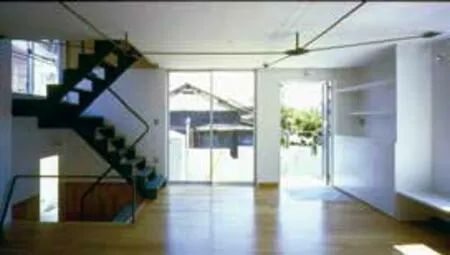
ANI 屋(日本,神奈川)ANI House (Chigasaki Kanagawa,Japan)
DL:So let's talk about future.When we talk about new type of people,it is also about mutation like the Covid-19.In Japan,disasters like earthquake become normal in our everyday life.One has to re-address new conditions.It is a very radical moment with many uncertainties for us to reconstruct our daily space.Is it true for your research in Japan?
YT:I think it's very important.It's a main subject of discussion about how we re-construct our life.Life in the city is totally dependent on the industrial services,which I always criticize as cold human resource.The Covid-19 and natural disasters show us how we depend on weak and fragile social networks.I propose to shift our way of living from the human resource to the resource for human,for which one can secure resource around and grasp food and energy by hands to construct life.Resource is very limited and controlled in the city.You go out from the city and make a hybrid form of life.In the weekend,I spend time in farming and then grasp food and energy from the mountain and fields.We cook by ourselves and become resourceful.Once,architecture,city and society have been designed for human resources;but I think we can redesign them for resourceful human.For people being dependent on industrial society network,it's a kind of lacking of life.
DL:So what's your next move of your research or practice?
YT:I am thinking about setting up a new School of Design in the mountain farming village where for the last two years I and my students have been working really hard and building traditional houses,community kitchen,guest house and gallery space with firewood and stock.We reopen the field occupied by weeds and bamboos and then start rice growing again.We also maintain the forest and utilize these trees for timber construction.We create this material circulation in the very limited local area.We learn the skills via nature,as well as very specific behaviors of farming activities with natural elements like mud,bamboos,seeds,trees and water.I'm very interested to construct a kind of curriculum for the new School of Design to teach new way of designing.It's a great shift of the playground.Four different universities,not necessarily architectural students,join this school of design to work on farms and forests and to understand the relational network of things.Small pavilions and tiny houses allow city people to stay.The materials for construction are from the place,based on the understanding of surrounding impacts.I'm very excited to work on this direction.
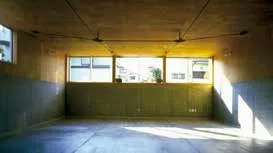
ANI 屋(日本,神奈川)ANI House (Chigasaki Kanagawa,Japan)

